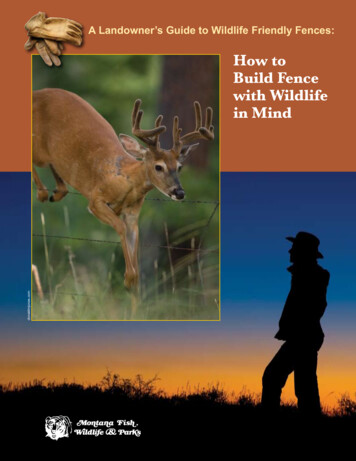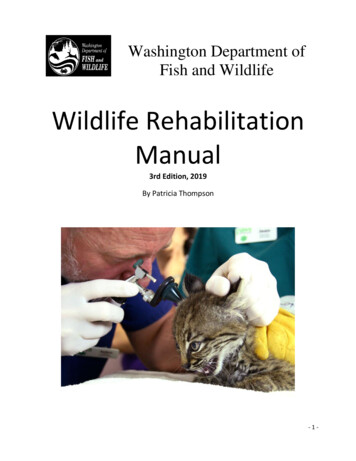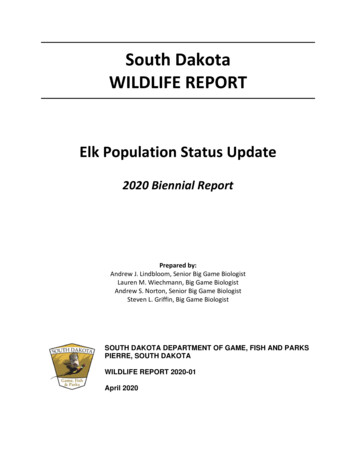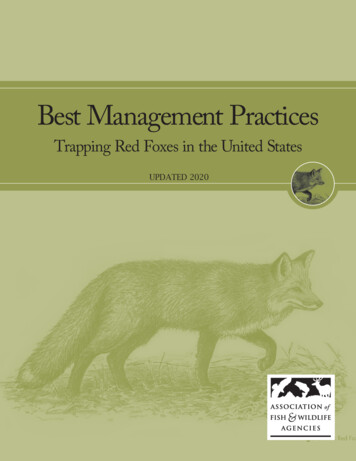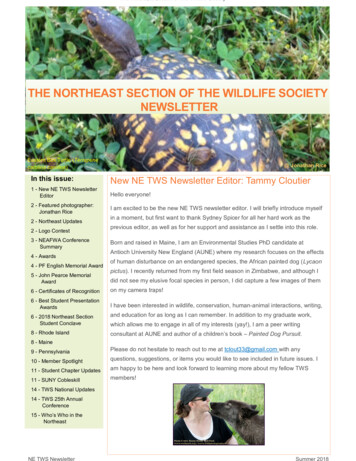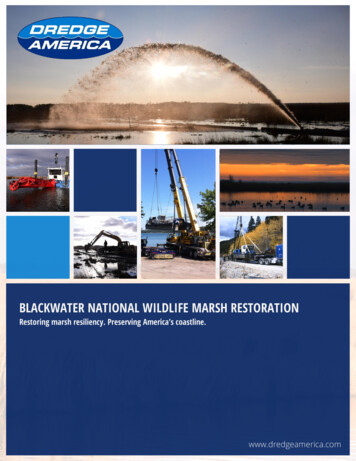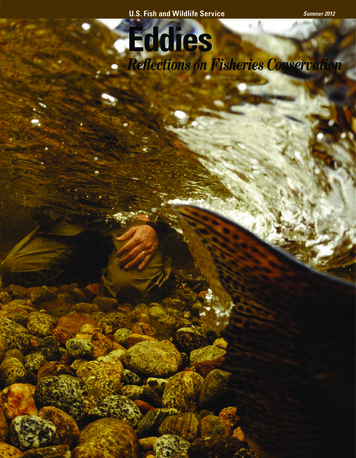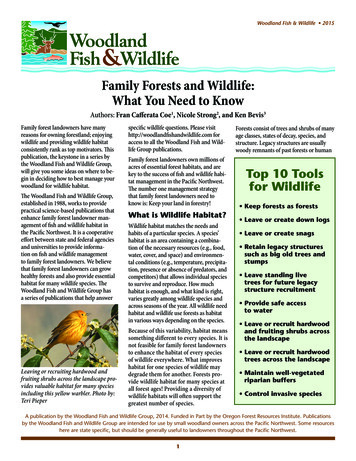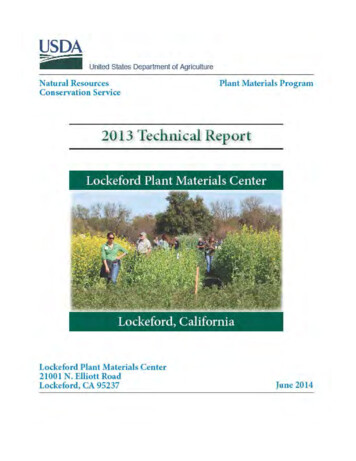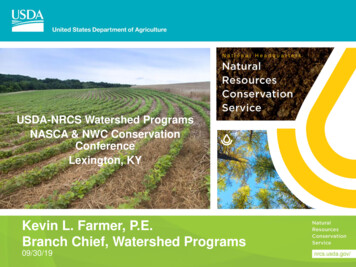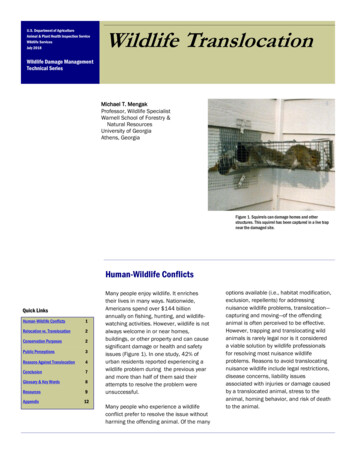
Transcription
U.S. Department of AgricultureAnimal & Plant Health Inspection ServiceWildlife ServicesJuly 2018Wildlife TranslocationWildlife Damage ManagementTechnical SeriesMichael T. MengakProfessor, Wildlife SpecialistWarnell School of Forestry &Natural ResourcesUniversity of GeorgiaAthens, GeorgiaFigure 1. Squirrels can damage homes and otherstructures. This squirrel has been captured in a live trapnear the damaged site.Human-Wildlife ConflictsQuick LinksHuman-Wildlife Conflicts1Relocation vs. Translocation2Conservation Purposes2Public Perceptions3Reasons Against Translocation4Conclusion7Glossary & Key Words8Resources9Appendix12Many people enjoy wildlife. It enrichestheir lives in many ways. Nationwide,Americans spend over 144 billionannually on fishing, hunting, and wildlifewatching activities. However, wildlife is notalways welcome in or near homes,buildings, or other property and can causesignificant damage or health and safetyissues (Figure 1). In one study, 42% ofurban residents reported experiencing awildlife problem during the previous yearand more than half of them said theirattempts to resolve the problem wereunsuccessful.Many people who experience a wildlifeconflict prefer to resolve the issue withoutharming the offending animal. Of the manyoptions available (i.e., habitat modification,exclusion, repellents) for addressingnuisance wildlife problems, translocation—capturing and moving—of the offendinganimal is often perceived to be effective.However, trapping and translocating wildanimals is rarely legal nor is it considereda viable solution by wildlife professionalsfor resolving most nuisance wildlifeproblems. Reasons to avoid translocatingnuisance wildlife include legal restrictions,disease concerns, liability issuesassociated with injuries or damage causedby a translocated animal, stress to theanimal, homing behavior, and risk of deathto the animal.
Page 2WDM Technical Series—Wildlife TranslocationTranslocation is appropriate in some situations such as reestablishing endangered species, enhancing geneticdiversity, and stocking species in formerly occupiedhabitats. The main focus of this publication, however, is toaddress nuisance wildlife issues that may be commonlyencountered by homeowners and nuisance wildlife controlprofessionals.Relocation Versus TranslocationRelocation is defined as moving an individual animal (orfamily group) from one location within its home range toanother location within the same home range. An exampleof relocation is moving a skunk trapped in a home’swindow well to the home’s backyard.Relocation, along with other appropriate activities (i.e.,barriers, habitat modification, scare devices, repellents) toprevent re-entry of the offending animal to an area, may beappropriate under certain conditions.Translocation is defined as capturing and moving a freeranging animal (or group of animals) from one location to anew location significantly distant from their original homerange or established territory. An example of translocationis driving a trapped squirrel 10 miles from its capture siteand releasing it on private property with permission fromthe landowner.With the exception of large carnivores (bears, mountainlions), translocation is rarely recommended as a methodfor solving human-wildlife conflicts because long-distancemovement can result in negative consequences for theanimal(s).Translocation for Conservation PurposesCaptive breeding and the release of captive bred animalsis an important conservation tool for restoring threatenedand endangered wildlife populations. Additionally, freeroaming wildlife are sometimes captured and translocatedFigure 2. The endangered black-footed ferret is one species whose recoveryhas been helped by captive breeding and translocation.with the goal of re-establishing populations in formerlyoccupied areas. Both are legitimate uses of translocation.Declining or endangered species, such as the Californiacondor (Gymnogyps californianus), black-footed ferret(Mustela nigripes) (Figure 2), gray wolf (Canis lupus), redwolf (C. rufus), Key Largo woodrat (Neotoma floridanasmalli), Allegheny woodrat (N. magister), and bald eagle(Haliaeetus leucocephalus) have benefitted fromtranslocation efforts. Translocation also has been used tore-establish more common wildlife species, such as wildturkey (Melagris galapavo), white-tailed deer (Odocoileusvirginianus), black bear (Ursus americanus), river otter(Lutra canadensis), beaver (Castor canadensis) (Figure 3),elk (Cervus elaphus), bighorn sheep (Ovis canadensis), andbison (Bison bison) into formerly occupied areas .
U.S. Department of AgricultureThe translocation of animals for conservation purposesrequires planning, a detailed analysis of the habitat, andconsideration of the long-term prospects for survival of thereleased animals. The ecological, economic, and societalconsequences of the release also are taken into account.This typically does not happen when a homeowner,rehabilitator, or nuisance wildlife control operatortranslocates a nuisance animal; the problem animal issimply caught and released in a place where people hope itwill live peacefully and without conflict. This is rarely thecase.Public Perceptions of TranslocationWildlife professionals recognize that wildlife populationsare impacted when people and development expand intoand occupy previously wild landscapes. Habitat loss canforce animals to leave an area or die, and the animals thatremain may cause nuisance or safety concerns. Otheranimals have simply adapted to urban and suburbanenvironments.Page 3Virginia, nuisance wildlife calls involving bear, deer,raccoons, and red fox (Vulpes vulpes) were the mostcommonly received complaints by the agency’s WildlifeHelpline during 2017.In addition to increases in urban and suburban wildlifeconflicts, people’s attitudes and perceptions toward wildanimals and wildlife damage management have alsochanged. Urban and suburban residents often lack thesame wildlife experiences that previous generations havehad with animals and are more likely to oppose wildlifehunting, trapping, or other forms of lethal control. Livetrapping and translocation, along with other non-lethalmanagement methods, such as fertility control, repellents,and behavior modification, are often preferred by thegeneral public for reducing human-wildlife conflicts inurban and suburban areas.Numerous public opinion surveys report that peoplebelieve translocation is an effective and humane methodfor addressing nuisance wildlife conflicts. However,research repeatedly shows that it is not. Similarly, it doesnot effectively control wildlife populations and rarelybenefits the animal.Over the last few decades, attacks by urban coyotes (Canislatrans) involving people and domestic dogs and cats haveincreased; conflicts between gardeners and suburban deerare more numerous; and costs associated with propertydamage by squirrels, chipmunks, snakes, bats, raccoons(Procyon lotor), armadillos (Dasypus novemcinctus), andother species continue to rise. Yet people may be unsure ofways to effectively deal with these wildlife nuisanceproblems.Surveys show that relatively few species are responsiblefor the majority of nuisance wildlife complaints. Between1992 and 2002 in Illinois, 88% of nuisance wildlifecomplaints involved raccoons, tree squirrels, opossums(Didelphis virginiana), striped skunks (Mephitis mephitis)(Figure 4), and woodchucks. In a survey conducted in 2017in Georgia, county cooperative extension service agentsreported that eight species—deer, feral swine, armadillos,moles, squirrels, birds in general, voles and snakes—accounted for 63% of the calls they received in 2016. InFigure 3. Beavers being translocated to a new habitat in Oregon in an effortto restore populations.
Page 4Reasons Against TranslocationThere are many reasons against the use of translocationto resolve wildlife conflicts. These include legal and policyissues as well as concerns related to the spread ofdisease, liability, stress to the animal, homing behavior,and survival rates of translocated animals.Legal and Policy IssuesWildlife translocation is illegal in most States and generallydiscouraged by Federal and State wildlife agencies.Professional wildlife groups and most private conservationorganizations strongly recommend against translocation asa method to address nuisance wildlife problems.For example, Georgia law prohibits the transport of wildlifefrom one location in the State to another unless the animalis in possession of the trapper and the trapper has theappropriate licenses or permits. Although this prohibitsmost Georgia citizens from trapping, transporting, andreleasing wild animals, translocation is still legal undersome circumstances. To avoid spreading disease, Georgiawildlife officials also suggest euthanizing species thatcommonly serve as rabies vectors (i.e., raccoons, skunks,foxes, coyotes, and bats) rather than translocating them.Figure 4. Striped skunks are one of the species most commonly involved inwildlife nuisance complaints.WDM Technical Series—Wildlife TranslocationIn Massachusetts, it is illegal to capture a wild animal andrelease it anywhere but on the property owned by theoriginal complainant. Rules and regulations governingnuisance wildlife control operators in Rhode Island,prohibit the translocation of any nuisance mammalcaptured alive (Rule 6.13, 2012).The U.S. Department of Agriculture’s (USDA) WildlifeServices (WS) program (WS Directive 2.501) and otherwildlife professionals state that the translocation of wildmammals is not a biologically sound practice. Severalnational and international veterinary associations includingthe American Veterinary Medical Association, the NationalAssociation of State Public Health Veterinarians, and theCouncil of State and Territorial Epidemiologists, oppose thetranslocation of wildlife because of disease risks.Numerous private organizations, such as The Fund forAnimals and the Audubon Society of Portland, also opposeor discourage translocation of nuisance wildlife.Disease ConcernsScientists, wildlife managers, and public healthprofessionals concerned about the spread of diseaseamong wildlife and people do not recommend the use oftranslocation. When animals are moved, the worms, ticks,fleas, viruses, bacteria, and other parasites that commonlylive on or in association with them are also moved. Thiscan lead to diseases appearing in previously unexposedwildlife populations far removed from the native range ofthe disease. In 1977, the raccoon strain of rabies viruswas first introduced into the Mid-Atlantic and Northeasternstates from translocated raccoons from Florida. Theconcern is valid even when moving animals shortdistances.While not all translocations result in disease outbreaks,moving animals may result in diseases being introducedinto naïve populations. Or, translocated animals may beexposed to unfamiliar diseases at their release sitesresulting in illness or death.Examples of diseases moved as a result of animaltranslocations include rabies, plague, chronic wasting
Page 5U.S. Department of Agriculturedisease, pneumonia, tuberculosis, brucellosis, and whirlingdisease in fish. Diseases encountered at release sitesinclude tick paralysis, botulism, tularemia, avian pox,bovine tuberculosis, and trypanosomiasis.An additional concern is human exposure to disease. Forinstance, a homeowner or other individual who moves arabid animal puts themselves and others at risk.Liability ConcernsThose who move wild animals may be liable for damagesassociated with that animal or diseases they spread.Consider if a state wildlife agency moved or sanctioned thetranslocation of a disease vector or dangerous animal,such as a bear or mountain lion. If the animal injured orkilled someone near the release site, the state agencycould be liable. Such an event occurred in Arizona whenthe state fish and wildlife department translocated anuisance black bear (Ursus americana). The bear laterattacked and mauled a young girl near the release site.The state settled the liability claim out of court for 4.5million.Federal, state, and local governments may elect totranslocate nuisance wildlife, such as black bears, toreduce human-wildlife conflicts. However, such actionshave an associated liability risk if the animal subsequentlycauses physical harm or property damage.Stress to the AnimalTranslocation, unlike dispersal, is not due to natural ordeliberate behavior. Being captured, translocated, andreleased can be stressful to a wild animal. This stress maycause many biological, physiological, and behavioralchanges. Acute stress can result in major changes tohormone levels and blood chemistry. The animal mayforego feeding and/or use limited fat reserves, leading topoor physical condition. This further reduces the animal’schances of survival.Research with farm animals shows that transportation in amotor vehicle can be stressful for animals. Research withwild animals shows that even indirect contact with peoplecan be stressful. For instance, the noise and vibration frommachinery, such as snowmobiles, are known to causeelevated levels of stress hormones in wild elk and wolves.Few research studies have followed the survival oftranslocated animals. However, of those (see Appendix),most conclude that translocation results in high mortalityrates due to predation and stress.Animals maintain social relationships with members oftheir own species. When an animal is removed throughtranslocation, trapping or hunting, these relationships aredisrupted. At the original capture site, remaining animalsmay fight to establish dominance in the absence of thetranslocated animal. Similarly, at the translocation site thenew animal must fight with residents to establish its placein the local hierarchy. The degree to which this occursdepends upon the species, habitat, and density of thespecies’ existing population at the release site. Atranslocated animal has no knowledge of nesting orroosting
urban residents reported experiencing a wildlife problem during the previous year and more than half of them said their attempts to resolve the problem were unsuccessful. Many people who experience a wildlife conflict prefer to resolve the issue without harming the offending animal. Of the many options available (i.e., habitat modification, exclusion, repellents) for addressing nuisance .
